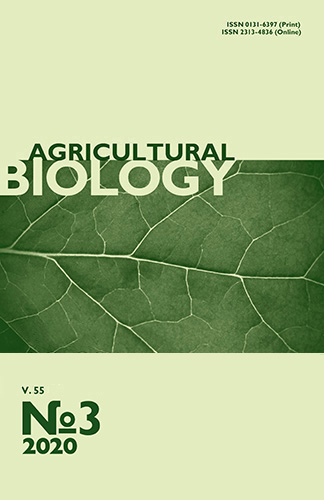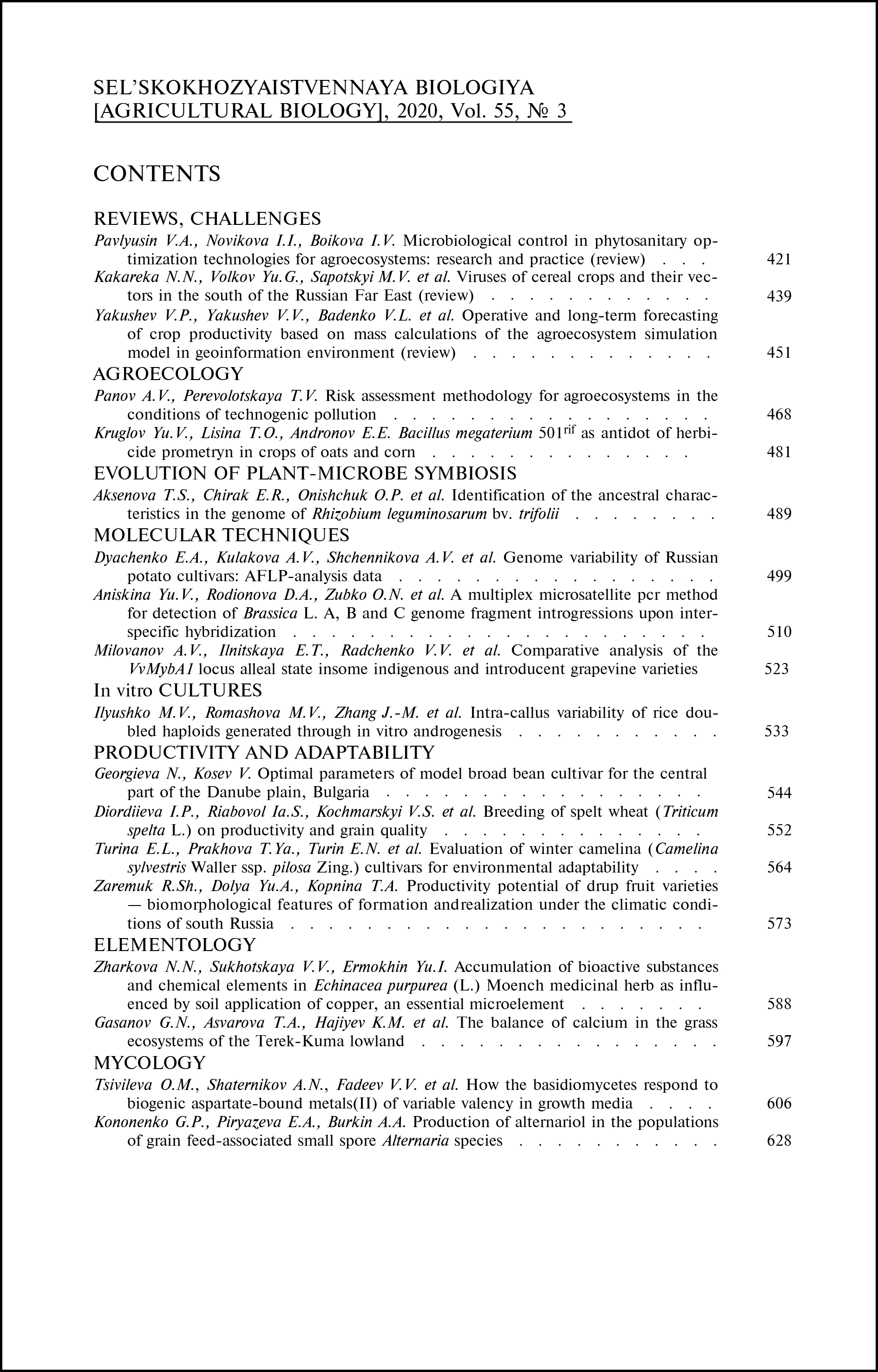doi: 10.15389/agrobiology.2020.3.552eng
UDC: 633.111.5:631.52
BREEDING OF SPELT WHEAT (Triticum spelta L.) ON PRODUCTIVITY AND GRAIN QUALITY
I.P. Diordiieva1, Ia.S. Riabovol1, V.S. Kochmarskyi2, L.O. Riabovol1
1Uman National University of Horticulture, Department of Genetics, Plant Breeding and Biotechnology, 1, Institutska vul., Uman, Cherkassy region, 20305 Ukraine, e-mail diordieva201443@gmail.com (✉ corresponding author), Genetika2015@udau.edu.ua, Liudmila1511@ukr.net;
2Experimental Farm «Elite» of Remeslo Mironovskyi Institute of Wheat NAASU, v. Central, Mironovskyi region, 08853 Ukraine,e-mail elitamip@ukr.net diordieva201443@gmail.com
ORCID:
Diordiieva I.P. orcid.org/0000-0002-8534-5838
Riabovol L.O. orcid.org/0000-0001-8988-4874
Riabovol Ia.S. orcid.org/0000-0003-4325-5313
Kochmarskyi V.S. orcid.org/0000-0002-1990-1808
Received February 5, 2020
Spelt (Triticum spelta L.) is an ancient specie of wheat demand for which is currently increasing. Along with positive characteristics of spelt (high protein, gluten and amino acids content, high adaptive potential, presence of a powerful stem and high resistance to lodging) it is significantly inferior to soft wheat T. aestivum L. in terms of yield capacity. However, new perspective genotypes with improved quantitative traits can be obtained from crosses of spelt and soft wheat due to introgression of genetic material of T. aestivum into T. spelta genome. In present research in result of hybridization of spelt wheat and soft wheat we obtained new forms which differ from each other in terms of morphobiological and economically valuable traits. The research aimed to create new initial material of spelt with high quality of grain based on hybridization of Triticum aestivum and T. spelta and its introduction to the breeding scheme for creating high productive varieties of the crop. Samples of spelt wheat obtained by the method of remote hybridization followed by multiple individual selection. Spelt samples of local breeding from foothill regions of the Carpathians and regionalized varieties of winter wheat Favoritka, Kharus, Panna, Ermak, Podolianka, Kryzhynka, Farandol, Kopilovchanka, Krasnodarskaia 99 were used as initial breeding material. Derived F1 hybrids were self-pollinated or back-crosses with parental forms. Hybrid progenies F2-5 were analyzed in terms of morphobiological and economically valuable traits (plant height, shape of the bush, wax coating on plants, pubescence on the stem and spike, length, color and awnedness of the spike, number of spikelets in the spike, density of the spike, threshing of grain, grain shape and color, weight of the grain from the main spike, number of productive stems per plant, 1000-grain weight, gluten and protein content, grain hardness, productivity). In fifth generation (F5) when segregation was no longer observed, considering productivity and quality of previous years, 18 best samples of spelt wheat were selected. Their field testing was conducted during 2012-2018 (F5-11) (a research field of Uman National University of Horticulture, right-bank Forrest-steppe of Ukraine, Cherkassy region). Gluten and protein contents were determined by infrared spectroscopy (Laboratory of genetics, breeding and seed production, a device InfratecTM Nova, FOSS Analytical, Sweden). Biometric traits (plant height, ear length, number of grains per ear, grain weight from head ear) were determined on 50 plants selected from each plot in two non-adjoin repetitions. Grain threshing was performed, and yield capacity was determined. From crossing, the collection of spelt initial material which include more than 200 samples was created. Obtained forms were divided into four groups according to plant height: semi-dwarf, low-growing, medium-growing and high-growing. In each group the best samples were selected which were analyzed for grain quality, yield and productivity structure. A possibility was proved of breeding improvement of spelt based on interspecific hybridization with soft wheat. It was established that eight samples significantly exceeded standard for yields. In the same time samples Nos. 76, 155, 1695 и 1725 had improved grain threshing (80-90 %), samples Nos. 76 and 1817 were characterized by high quality, in particular, 25.2 and 22.0 % protein content, respectively, and 52.1 and 44.7 % gluten level. Samples Nos. 40 and 13 were the best in terms of gluten and protein content with 30.1 and 27.2 % for protein, and 63.2 and 56.5 % for gluten, respectively. As a result of the study, spelt wheat forms were selected which possess several valuable traits, i.e. the sample No. 124 is distinguished due to low plant height (92 cm) and high quality traits (1000-grain weigh of 53.8 g, protein content of 17.9 %, I group gluten level of 37.4 %), while the sample No. 155 shows high productivity (5.36 t/ha) and an improved grain threshing out from the ear (92 %). A winter spelt variety Europe derived from spelt and soft wheat hybridization has been listed to State register of plants suitable for growing in Ukraine from 2015.
Keywords: spelt wheat, soft wheat, hybridization, yield capacity, grain threshing, protein content, gluten content.
REFERENCES
- Packa D., Załuski D., Graban Ł., Lajszner W. An evaluation of spelt crosses for breeding new varieties of spring spelt. Agronomy, 2019, 9(4): 167 CrossRef
- Matsuoka Y. Evolution of polyploid Triticum wheats under cultivation: the role of domestication, natural hybridization and allopolyploid speciation in their diversification. Plant and Cell Physiology, 2011, 52(5): 750-764 CrossRef
- Dvorak J., Deal K.R., Luo M.-C., You F.M., von Borstel K., Dehghani H. The origin of spelt and free-threshing hexaploid wheat. Journal of Heredity, 2012, 103(3): 426-441 CrossRef
- Nіnієva A.K., Kozub N.O., Sozіnov I.O., Ribalka O.I., Leonov O.Yu., Tverdokhlіb O.V., Boguslavs'kii R.L. Vіsnik ukraїns'kogo tovaristva genetikіv і selektsіonerіv, 2013, 11(1): 96-105.
- Lacko-Bartošová M., Korczyk-Szabó J., Ražný R. Triticum spelta — a specialty grain for ecological farming systems. Research Journal of Agricultural Science, 2010, 42(1): 143-147.
- Ruibal-Mendieta N.L., Delacroix D.L., Mignolet E., Pycke J.M., Marques C., Rozenberg R., Petitjean G., Habib-Jiwan J.-L., Meurens M., Quetin-Leclercq J., Delzenne N.M., Larondelle Y. Spelt (Triticum aestivum spp. spelta) as a source of bread making flours and bran naturally enriched in oleic acid and minerals but not phytic acid. Journal of Agricultural and Food Chemistry, 2005, 53(7): 2751-2759 CrossRef
- Diordiieva I., Riabovol L., Riabovol I., Serzhuk O., Novak A., Kotsiuba S. The characteristic of wheat collection created by Triticum aestivum L./Triticum spelta L. hybridization. Agronomy Research, 2018, 16(5): 2005-2015 CrossRef
- Geisslitz S., Longin C.F.H., Scherf K.A., Koehler P. Comparative study on gluten protein composition of ancient (einkorn, emmer and spelt) and modern wheat species (durum and common wheat). Foods, 2019, 8(9): 409 CrossRef
- Sobczyk A., Pycia K., Stankowski S., Jaworska G., Kuzniar S. Evaluation of the rheological properties of dough and quality of bread made with the flour obtained from old cultivars and modern breeding lines of spelt (Triticum aestivum ssp. spelta). Journal of Cereal Science, 2017, 77: 35-41 CrossRef
- Arzani A., Ashraf M. Cultivated ancient wheats (Triticum spp.): a potential source of health‐beneficial food products. Comprehensive Reviews in Food Science and Food Safety, 2017, 16(3): 477-488 CrossRef
- Gospodarenko G.M, Lyubich V.V., Polyanets'ka I.O. Vіsnik Umans'kogo natsіonal'nogo unіversitetu sadіvnitstva, 2016, 2: 44-48.
- Gospodarenko G.M., Kostogriz P.V., Lyubich V.V., Parіi M.F., Poltorets'kii S.P., Polyanets'ka I.O., Ryabovol YA.S., Ryabovol L.O., Sukhomud O.G. Pshenitsya spel'ta. Monografiya. Kiїv, 2016.
- Mitrofanova O.P. Vavilovskii zhurnal genetiki i selektsii, 2012, 16(1): 10-20 (in Russ.).
- Sіchkar S.M., Morgun V.V., Dubrovna O.V. Faktori eksperimental'noї evolyutsії organіzmіv, 2016, 18: 149-153.
- Liu G., Xu S.B., Ni Z.F., Xie C.J., Qin D.D., Li J., Lu L.H., Zhang J.P., Peng H.R., Sun Q.X. Molecular dissection of plant height QTLs using recombinant inbred lines from hybrids between common wheat (Triticum aestivum L.) and spelt wheat (Triticum spelta L.). Chinese Science Bulletin, 2011, 56(18): 1897-1903 CrossRef
- Nemeth C., Yang C., Kasprzak P., Hubbart S., Scholefield D., Mehra S., Skipper E., King I., King J. Generation of amphidiploids from hybrids of wheat and related species from the genera Aegilops, Secale, Thinopyrum, and Triticum as a source of genetic variation for wheat improvement. Genome, 2015, 58(2): 71-79 CrossRef
- Babenko L.M., Hospodarenko H.M., Rozhkov R.V., Pariy Y.F., Pariy M.F., Babenko A.V., Kosakivska I.V. Triticum spelta: Origin, biological characteristics and perspectives for use in breeding and agriculture. Regulatory Mechanisms in Biosystems, 2018, 9(2): 250-257 CrossRef
- Osokina N., Liubych V., Novak L., Pushkarova-Bezdil T., Priss O., Verkholantseva V., Hryhorenko O., Pusik V., Pusik L. Elucidation of the mechanism that forms bread baking properties of the spelt grain. Eastern European Journal of Enterprise Technologies, 2018, 2/11(92): 39-47 CrossRef
- Ribalka O.I. Yakist' pshenitsi ta iї polipshennya. Monografіya [Wheat quality and its improvement. A monograph]. Kiїv, 2011.
- Parіi F.M., Sukhomud O.G., Lyubich V.V. Nasіnnitstvo, 2013, 5: 5-6.
- Dіordієva I.P. Genetichnі resursi roslin, 2018, 23: 25-34.
- Tverdokhlіb O.V., Golik O.V., Nіnієva A.K., Boguslavskii R.L. Posіbnik Ukraїns'kogo khlіboroba, 2013, 2: 154-155.
- Derzhavnii reєstr sortіv roslin, pridatnikh dlya poshirennya v Ukraїnі v 2019 r. Kiїv, 2019 (in Russ.).
- Metodika Derzhavnoї naukovo-tekhnіchnoї ekspertizi sortіv roslin. Metodi viznachennya pokaznikіv yakostі produktsії roslinnitstva [Methods of State scientific and technical examination of plant varieties. Methods for determining quality of crop products]. Kiїv, 2015.
- Dorofeev V.F., Udachin R.A., Semenova L.V. Pshenitsy mira [Wheats of the world]. Leningrad, 1987 (in Russ.).
- Ermantraut E.R., Gudz" V.P. Materialy Mezhdunarodnoi nauchno-prakticheskoi konferentsii «Sovremennye problemy opytnogo dela» [Proc. Int. Conf. «Modern problems of experimental research»]. St. Petersburg, 2000, 2: 13-134 (in Russ.).
- Kochmars'kii V.S. Tavrіis'kii naukovii vіsnik, 2012, 78: 33-38 (in Russ.).
- Longin C.F.H., Ziegler J., Schweiggert R., Koehler P., Carle R., Würschum T. Comparative study of hulled (einkorn, emmer, and spelt) and naked wheats (durum and bread wheat): agronomic performance and quality traits. Crop Science, 2016, 56(1): 302-311 CrossRef
- Rapp M., Beck H., Gütler H., Heilig W., Starck N., Römer P., Cuendet C., Kurz H., Uhlig F., Würschum T., Friedrich C., Longin F. Spelt: agronomy, quality, and flavor of its breads from 30 varieties tested across multiple environments. Crop Science, 2017, 57(2): 739-747 CrossRef
- Tverdokhleb E.V., Boguslavskii R.L. Vіsnik Kharkіvs'kogo natsіonal'nogo agrarnogo unіversitetu, 2010, 2(20): 88-95 (in Russ.).
- Ivanovska S., Kraljević-Balalić M., Stojkovski C. Diallel analysis for plant height in winter wheat. Genetika, 2003, 35(1): 11-19 CrossRef
- Sіchkar S.M., Morgun V.V., Dubrovna O.V. Uspadkuvannya morfologіchnikh oznak u gіbridіv F1-F2 T. spelta × T. aestivum. Fiziologiya rastenii i genetika, 2016, 48(4): 344-355.
- Gulkanyan V.O. Biologicheskii zhurnal Armenii AN Armenii, 1971, 23(4): 41-49 (in Russ.).
- Grant N.P., Mohan A., Sandhu D., Gill S.K. Inheritance and genetic mapping of the reduced height (Rht18) gene in wheat. Plants, 2018, 7(3): 58-67 CrossRef
- Pshenitsa. Tekhnicheskie usloviya: GSTU 3768:2010. Kiev, 2010.
- Faris J.D., Simons K.J., Zhang Z., Gill B.S. The wheat super domestication gene Q. Frontiers of Wheat Bioscience, 2005, 100: 129-148.












